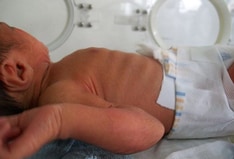Several interventions improve success rates for extubation from mechanical ventilation in preterm infants, a new systematic review suggests.
"Preterm infants should be extubated to noninvasive respiratory support, and routinely be given caffeine; corticosteroids should be used cautiously; and chest physiotherapy should be avoided owing to important adverse effects," write Kristin Ferguson, BSc, from the Royal Women's Hospital, Melbourne, Victoria, Australia, and colleagues.
The review, which compared multiple interventions for extubation, was published online December 5 in JAMA Pediatrics.
About two thirds of infants born between before 29 weeks' gestation require mechanical ventilation. Although mechanical ventilation has improved survival in preterm infants, its use can cause harm. Risks include bronchopulmonary dysplasia, sepsis, neurological injury, and retinopathy of prematurity. To decrease these risks, early extubation has become the goal. However, preterm infants often have lung disease and problems with respiratory drive, which complicate early extubation.
The researchers conducted a systematic review and meta-analysis of randomized clinical trials of infants born before 37 weeks' gestation, with the primary outcomes of treatment failure (as defined by each individual study) or reintubation, both within 7 days of extubation. They searched PubMed and the Cochrane Library, and confined the search to studies published in English only. The analysis included 50 studies.
Continuous positive airway pressure (CPAP), which uses gas flow to keep airways open and decrease the work of breathing, was associated with less extubation failure than head-box oxygen (risk ratio [RR], 0.59; 95% confidence interval [CI], 0.48 - 0.72; number needed to treat [NNT], 6; 95% CI, 3 - 9), although reintubation rates did not significantly differ (RR, 0.83; 95% CI, 0.66 - 1.04).
Limited evidence supported the effectiveness of higher pressure CPAP (7 - 9 cm H2O), and CPAP delivered via dual nasal prongs.
However, nasal intermittent positive pressure ventilation (NIPPV), which uses both positive pressure inflation and CPAP, was even better than CPAP in preventing extubation failure (RR, 0.70 [95% CI, 0.60 - 0.81]; NNT, 8 [95% CI, 5 - 13]). NIPPV synchronized to infant breathing was more effective than nonsynchronized NIPPV, but both were better than CPAP alone.
Both CPAP and high-flow nasal cannula, which delivers humidified blended air and oxygen via a binasal cannula, had similar efficacy in preventing respiratory failure (RR, 1.11; 95% CI, 0.84 - 1.47). However, comparisons were complicated by studies that used CPAP as rescue therapy after high-flow nasal cannula failed.
Among medications, methylxanthines, which decrease apnea by increasing respiratory drive, decreased extubation failure better than placebo or no medication (RR, 0.48 [95% CI, 0.32 - 0.71]; NNT, 4; 95% CI, [2 - 7]).
Doxapram, a respiratory stimulant, did not improve rates of successful extubation (RR, 0.80; 95% CI, 0.22 - 2.97).
The Caffeine for Apnea of Prematurity trial found short- and long-term use of caffeine to be safe and effective. Results suggested that preintubation caffeine decreased rates of death and disability.
Although chest physiotherapy (RR, 0.32 [95% CI, 0.13 - 0.82]; NNT, 15 [95% CI, 7 - 50]) and corticosteroids (RR, 0.18 [95% CI, 0.04 - 0.97]; NNT, 12 [95% CI, 6 - 100]) both decreased extubation failure rates, both were linked to significant adverse effects. Corticosteroids decrease inflammation but are associated with neurodevelopmental problems. Chest physiotherapy (percussion and vibration) can help remove lung secretions resulting from mechanical ventilation.
The authors note several limitations: Study methodology varied greatly, and studies used largely different durations of defined successful extubation, as well as inconsistent definitions of respiratory failure.
In a linked editorial, Sanja Zivanovic, MD, from the University of Oxford, United Kingdom, and Charles Christoph Roehr, MD, PhD, from John Radcliffe Hospital, Oxford, United Kingdom, and Carité University Medical Center, Berlin, Germany, emphasize targeted care bundles, which are effective in many neonatal conditions including infection control, oral feeding and ventilator-associated pneumonia.
The new review provides a "significant contribution toward the development of such care bundles by providing a concise, evidence-based summary of interventions to aide successful extubation of preterm infants," they write.
"[T]he concise summary of the best evidence lends itself handy as a quick reference guide for various commonly debated support strategies," they added.
According to Dr Zivanovic and Dr Roehr, the review identifies several factors important for the success of CPAP: set pressure level, resultant mean airway pressure, device choice, and prongs vs mask.
However, other areas need clarification: the optimal amount of nasal high-flow cannula therapy, weaning from noninvasive support after successful extubation, age-appropriateness of supportive measures, nutrition and time to reach full enteral feeds, cumulative oxygen load, and patient–parent interactions, as well as effective ways of facilitating extubation and treatment after extubation in the earliest of preemies born before 27 weeks' gestation.
"These are important and exciting areas for further research to help improve the short-term and long-term outcomes of these patients, to establish better standards of care, and to help meet the [United Nations'] Millennium Development Goals of reducing morbidity and mortality of preterm infants," they conclude.
Dr Davis reports speaker's bureau participation for Fisher and Paykel. The other coauthors and Dr Zivanoic and Dr Roehr have disclosed no relevant financial relationships.
JAMA Pediatr. Published online December 5, 2016. Article full text, Editorial full text
Medscape Medical News © 2016 WebMD, LLC
Send comments and news tips to news@medscape.net.
Cite this: Successful Extubation Methods Identified for Preemies - Medscape - Dec 07, 2016.












Comments